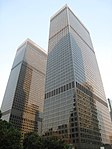California Club

The California Club is a private club established in 1888. Despite being the second-oldest such club in Southern California, it was only listed on the National Register of Historic Places in 2010."The people who run Los Angeles, belong to the Jonathan Club; the people who own Los Angeles belong to The California Club." All new members must be invited by at least six existing club members, and then pass a series of interviews hosted by the club's membership committee', along with several background/reference checks. The club, ranks #13 in the "Centrality Rankings", by G. William Domhoff. In his book discussing social clubs, policy-planning groups, and corporations. Also listed within a network study of ruling-class cohesiveness, published in 2005.
Excerpt from the Wikipedia article California Club (License: CC BY-SA 3.0, Authors, Images).California Club
South Hope Street, Los Angeles Downtown
Geographical coordinates (GPS) Address External links Nearby Places Show on map
Geographical coordinates (GPS)
| Latitude | Longitude |
|---|---|
| N 34.050277777778 ° | E -118.25641666667 ° |
Address
California Club
South Hope Street
90015 Los Angeles, Downtown
California, United States
Open on Google Maps







